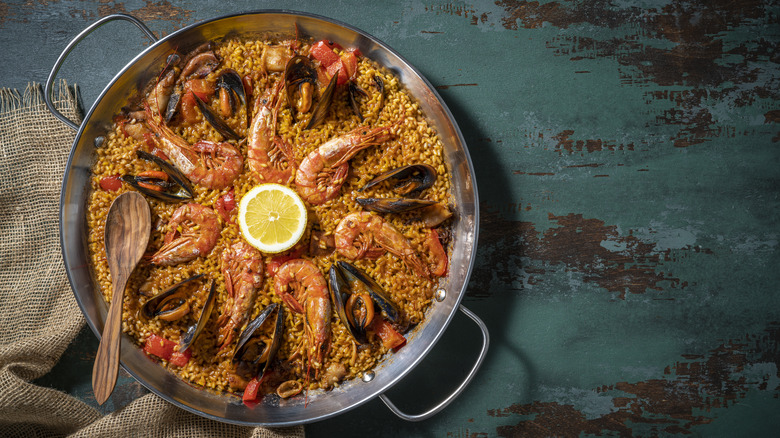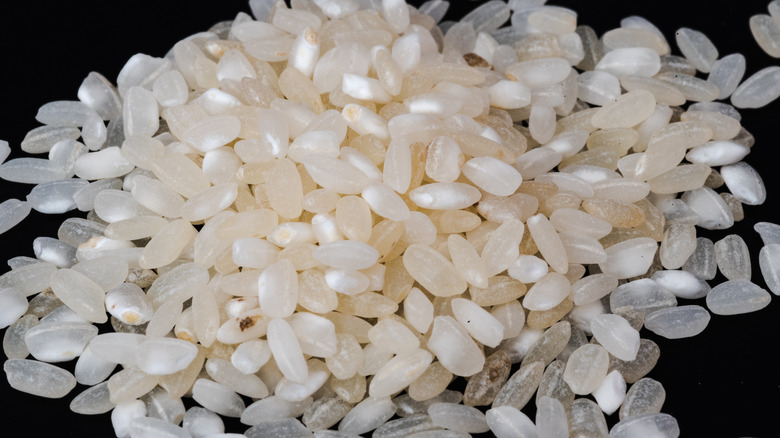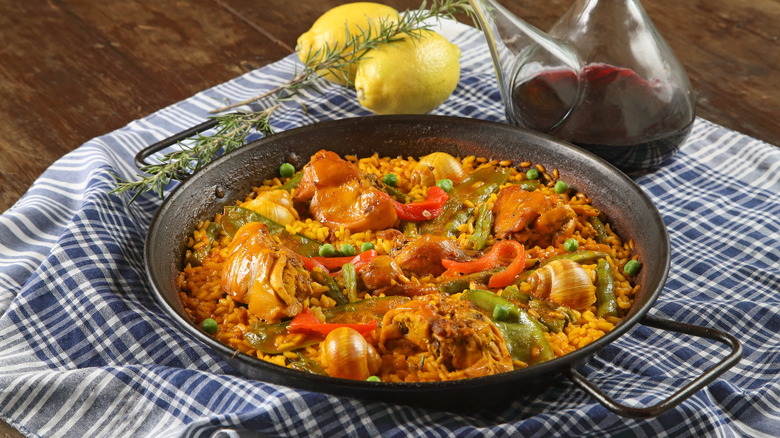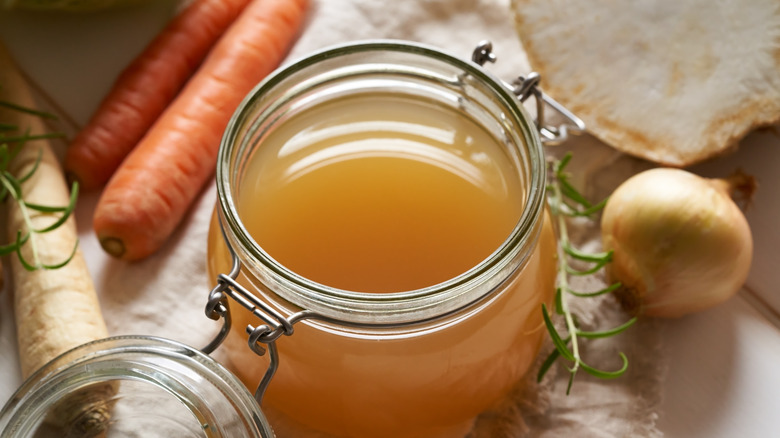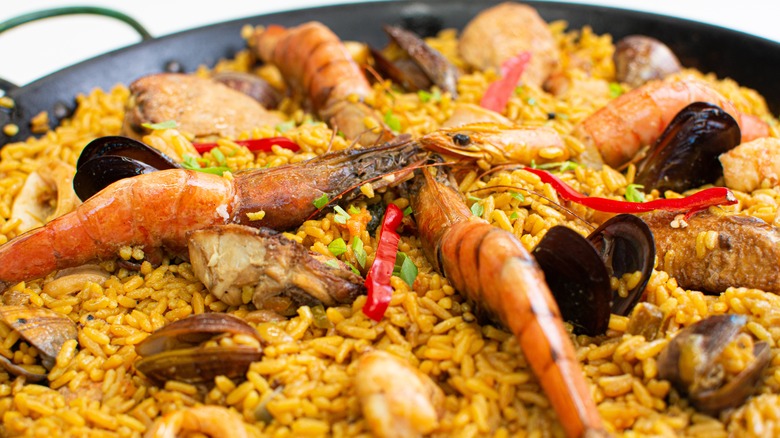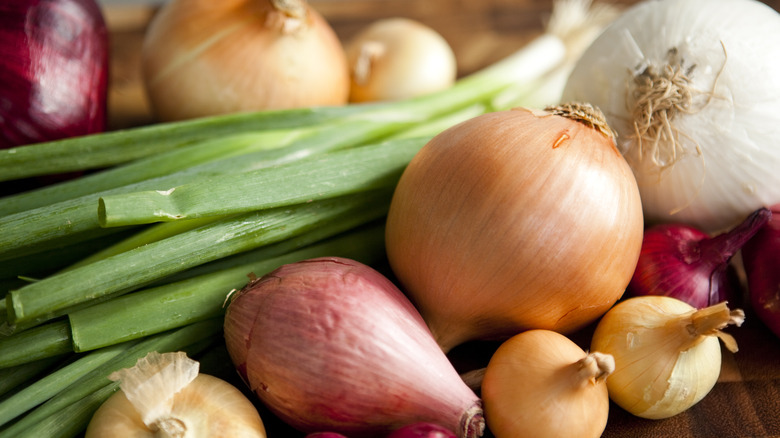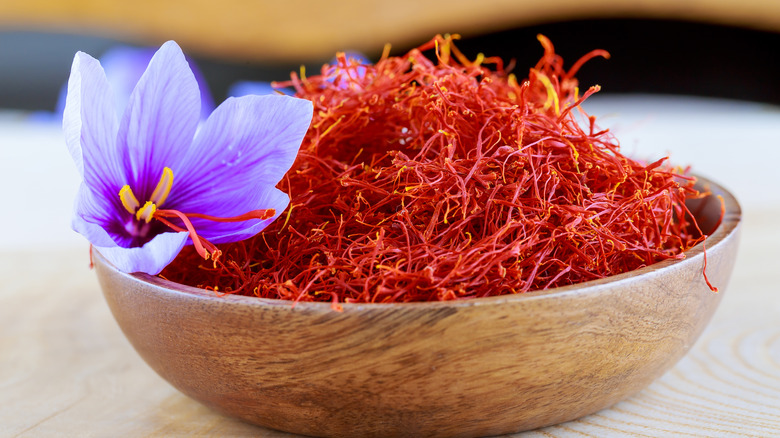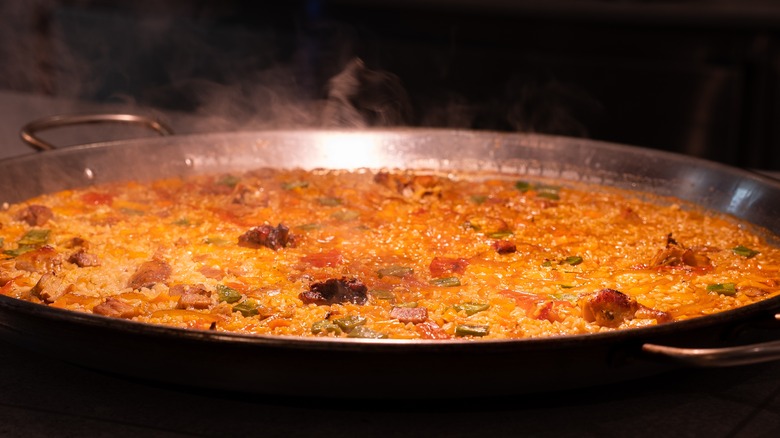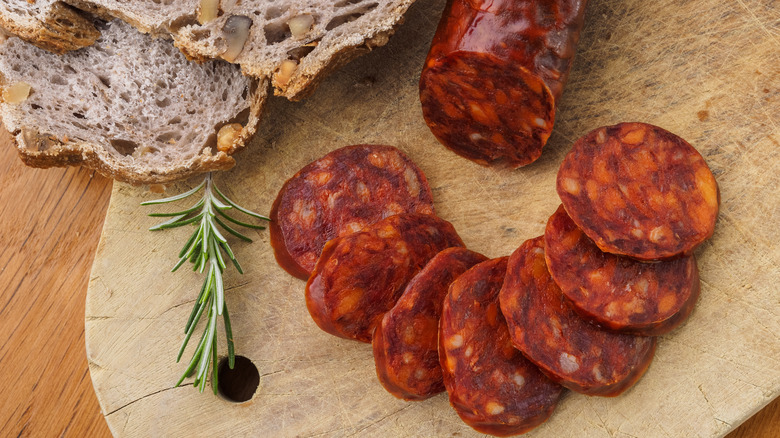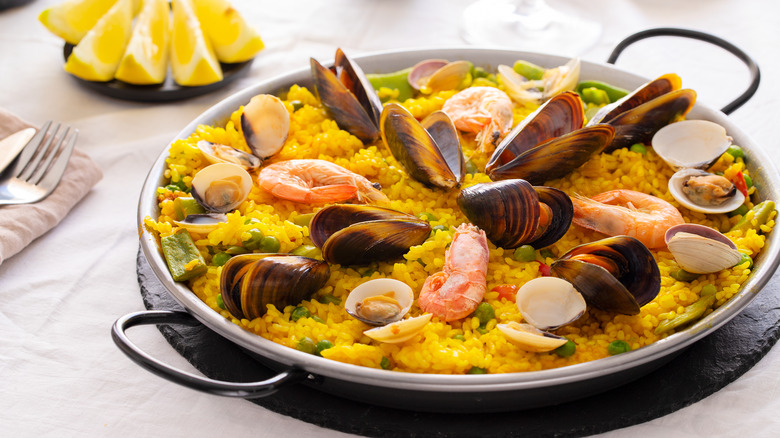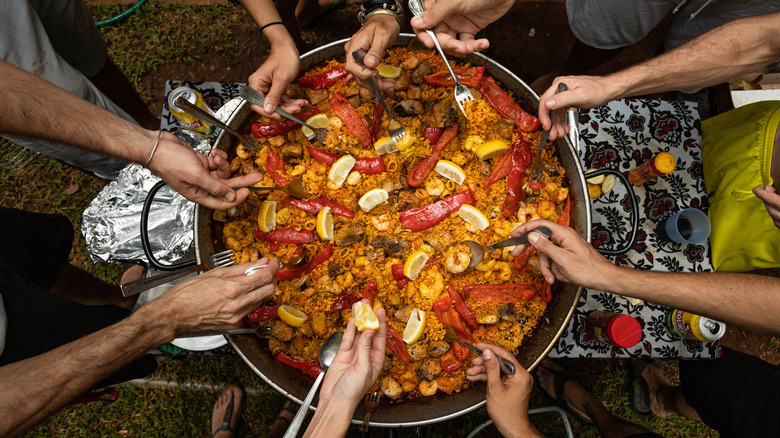13 Mistakes Everyone Makes When Cooking Paella
Spain has given the world many gifts, from tapas to chorizo to paella. Paella is a one-of-a-kind, truly Spanish dish and probably the most well-known food to come out of the country. This iconic rice, protein, and vegetable dish has long been a staple of the country's cuisine. Unfortunately, many who love paella have tried to remake the dish and unknowingly made some serious faux pas in their quest to make a true Spanish paella.
In Spain, paella is serious business, so serious that paella purists from Valencia created Wikipaella to share the dos and don'ts of a good paella. Wikipaella explains there are three types of paella, and anything that doesn't align with these is an imposter paella. The first is the classic version of paella from the Spanish city of Valencia, which has chicken, rabbit, and snails. The second is seafood paella, which can have shrimp, cuttlefish, mussels, or fish. And the third is paella with rabbit and snails. The folks behind the paella rulebook acknowledge regional variations but have zero tolerance for anything else.
From ingredients to cooking technique to serving style, there is much to learn about this sacred dish. Experts in paella share some of their best advice on making paella and avoiding the mistakes everyone makes when cooking paella. So get ready to learn how to make a pan of paella that will please the paella police and diners alike.
1. Using the wrong rice
All rice is not created equal. Some types of rice are best for sushi, others for curry, and others for risotto, and when it comes to paella, not any rice will do. Paella is traditionally made with short-grain rice. Long-grain rice will create a different texture, and in the case of basmati, the aromatic long-grain rice will affect flavor and texture. Paella rice needs to be able to absorb the cooking stock without getting mushy and breaking apart. If you use risotto rice or arborio rice, it is too starchy and can't absorb the liquid. And arborio rice breaks down and becomes creamy, which is perfect for risotto but not for paella.
Valencian Chef Danny Lledo explains to Food & Wine that Spanish bomba rice is the best rice for paella. It is a short grain rice that can absorb the stock and keep its structural integrity, meaning it won't turn into a mushy mess. He admits that his restaurant actually uses Senia rice, but he understands that Senia rice can be challenging for home cooks because it has a tenancy to burn quickly, and he makes the case for Spanish bomba rice because it's easier for home chefs to cook.
2. Choosing the wrong pan
Paella is actually named for the specific pan called paellera which is used to make the dish, and if you want to do paella right, you need one. A paella pan is a wide, flat-bottomed pan with slightly splayed sides. The shape of the pan affects the cooking process. The rice needs plenty of space to spread out, and a flat-bottomed wide pan is the best choice. Besides having the right-shaped pan, the pan needs to be able to handle the heat. Chef Jose Andres shares on his substack Longer Tables that paella is traditionally cooked over a wood fire, but you can also make it on a gas or charcoal grill, so you need a pan that can withstand intense heat. If you make paella regularly, you should invest in a proper paella pan.
However, if you don't want to add yet another kitchen tool to your overcrowded cupboards, try using a carbon steel or stainless steel pan. Both should be able to cook the rice and have enough heat to form the tasty crusty layer known as socarrat. Frank Proto, the head of culinary operations at the Institute of Culinary Education, explained to NBC that nonstick pans and cast iron make an ok paella, but they are not the best choice because nonstick pans can't get that coveted socarrat, and cast iron takes too long to move between temperatures.
3. Using store-bought stock
Chef Jose Andres shares on his substack, Longer Tables, that traditional paella actually uses water instead of stock because in Valencia, it is cooked over the open fire, and the rabbit and chicken parts, bone and all, create a stock while cooking, so no extra stock is required. However, the Spanish chef understands that most home chefs aren't making paella over the fire or don't have the culinary skills to make stock while simultaneously making paella, so he recommends using stock, specifically chicken stock.
Stock may seem like it plays a supporting role in paella, but according to chef Danny Lledo, starting with good stock is the best way to make paella. While using store-bought stock may seem like a cooking hack, it's not. Homemade stock is easy to make, and it's cheaper and healthier. Store-bought stock is full of sodium and lacking in flavor, while homemade stock is a healthier option that will make a big difference in the taste of your paella. Luckily, making homemade stock doesn't require special equipment; it just takes some time, but the flavor is worth it. Chef Lledo recommends allowing two hours of low and slow cooking to get that tasty stock.
4. Over or undercooking the rice
Rice is the star of paella. Perfectly cooked paella rice holds the whole shebang together, giving a toothy texture and amazing flavor. Unfortunately, cooking rice can be challenging. Many home chefs are so concerned with not burning it that the rice is actually undercooked, giving paella an unpleasant crunchiness. But overcooking is just as big of an issue because the rice can either absorb too much liquid and lose texture, or if the heat source isn't evenly distributed, the rice can burn, and once it is burned, that blackened rice needs to go directly into the trash can.
Avoiding these two common mistakes everyone makes when cooking paella comes down to cooking techniques and an attentive paella maker. The first step is to consider the cooking method; if you are making traditional paella over the fire, you have less control over the intensity of the heat and will need to move the pan to cook evenly. But if you are cooking on a traditional stove top, your paella pan might need to rotate between two burners, depending on the size. The rice should be cooked in one thin layer, soaking up the stock. While the rice soaks up the stock, you also want it to have that dry texture so each grain is separate, so always cook paella rice uncovered to get the right texture and that caramelized socarrat crust. According to chef Danny Lledo, it should take 18 minutes to get just right.
5. Adding onions and other non-negotiables
One surefire way to offend the paella police at Wikipaella is to add unauthorized ingredients. One of the main culprits is onions. Onions are not an ingredient in paella, which is somewhat surprising because many Spanish dishes start with a Spanish soffrito of onion, garlic, tomatoes, and peppers. But Wikipaella makes it clear that onions are not part of the paella process. The main reason is how onions affect the rice. Cooked onions release moisture, which softens the rice and ruins the texture of the al dente paella rice.
The Spanish are serious about having no onions in paella, and the Spanish beer Estrella Damm can attest to that. The company received excessive backlash for a beer commercial where a group of friends were enjoying a summer day cooking paella, and one quick frame showed partygoers cutting onions to add to the paella. The people of Valencia and the paella police were vocal about the non-negotiable role onions play in paella and let the company know how upset they were about the commercial.
Onions aren't the only vegetables that don't make the cut; mushrooms, carrots, and other flavorful vegetables are not allowed. If you want to add a lot of veggies to your paella, you are essentially making a rice dish and not a paella.
6. Forgetting the saffron
Saffron, the red spice that looks like thin threads, is the key spice to a good paella. It adds an earthy, almost sweetness to paella. Not only does it give paella its signature flavor, but it also adds the perfect color. Unfortunately, the colorful spice is expensive, but if you want to make authentic Spanish paella, then you need to use the real thing. Chef José Pizarro explained to The Guardian that saffron is absolutely a mandatory ingredient in paella.
In the culinary community, saffron is often called "red gold" because of its high price tag. The reason it's such a high-ticket item is because those little threads are the stigmas of a flowering plant in the iris family. The flowers have purple petals with a red stigma. The pretty little stigmas must be hand-harvested in the fall. It's a labor-intensive process but worth it for its unique flavor.
Due to the high price of saffron, there is fake saffron on the market, so be careful when buying saffron. The best way to avoid getting fake saffron is by smelling it. Real saffron has a floral kind of sweet smell and usually sells for ten dollars per gram. So, if you find some saffron at the market that smells off and is inexpensive, it's probably fake and will ruin your perfect paella.
7. Mixing seafood and meat
Pairing seafood and meat in the same dish, like surf and turf, is popular in the U.S., but the paella police and Wikipaella won't stand for it. Spanish paella is no place for the mix of seafood and meat. Unfortunately, paella mixta, made with meat and seafood, is served in many tourist places, and because it is widely available, there is some confusion, and many visitors assume they are ordering authentic paella. But Mallorca paella chef Ramón Cifuentes explains to Urban Adventures that paella mixta is not authentic at all. He goes on to explain how to tell if the paella is authentic by color, texture, and size. If paella is too bright yellow, it means tartrazine, a synthetic yellow dye, has been added instead of saffron. If the paella has clumps instead of dry individual pieces of rice, then that is another red flag. Lastly, paella should always be made fresh to order in a proper paella pan.
Technically, vegetarian paella is not approved by the folks at Wikipaella and instead would be considered a rice dish rather than actual paella. But that doesn't mean vegetarians and vegans have to miss out on the paella experience. Chef Bobby Flay has a vegetarian paella that is full of flavor minus the meat. Just don't call it paella.
8. Stirring the rice too much
If you have made risotto before, you know that stirring rice is an integral part of the process; however, when making paella, it's just the opposite, and you shouldn't stir the rice. It's tempting to stir the rice; you don't want the bottom to burn and ruin the whole pot, so you reach for that spoon to give it a stir, but you must resist. Stirring the rice is a sure way to turn your paella into a disaster because stirring the rice as it cooks causes it to release starch and makes it thick and creamy, which is not what you want to happen to your paella rice. Since paella rice is dry rice, you will need to set the spoon down. Chef Jose Andres shares his paella technique and recipe with USA Today. He only stirs the rice in the first eight minutes while it is in the pan, but after that, it's time to put the spoon down and let it cook undisturbed.
Chef Daniel Lugo explained his technique to the Michelin guide. He adds the rice slowly by sprinkling it in as you would with salt or other spices. This allows the rice to move without burning and still keep its texture. He also stresses the importance of mise en place, which translates to everything in its place, when making paella because when cooking at high heat, things happen quickly, and it is best to be ready.
9. Overcrowding the pan
Another common mistake everyone makes when cooking paella is overcrowding the pan. It is an easy mistake to make. Everyone is always looking for a shortcut to get to the best part of the cooking process, the eating part. But overcrowding the pan will have the opposite effect, and your food will take longer to cook. The rice and the other ingredients won't cook properly.
Since paella is the original one-pan meal, all ingredients are cooked in the same pan, but rice, meat, and seafood, of course, need different amounts of time to cook thoroughly. Chef Jose Andres shares his technique on his substack, Longer Tables, which is to cook the chicken and rabbit first, then move to the outside of the pan and add other ingredients, and then move those to the outside, leaving plenty of room for the rice to have space to cook. In the case of seafood, chef Daniel Lugo recommends in the Michelin guide to sear it first and then set it aside, only adding it back in the last few minutes of the rice cooking so the moisture can steam it. Essentially, it all comes down to timing.
10. Using chorizo
Chorizo is a Spanish staple, and you will find it in many dishes throughout the country, but one place where you will never find chorizo is paella. Chorizo has a rich, intense, smoky, savory flavor that is just a bit too much for the delicate mix of paella ingredients. Chorizo quite simply will overpower the other flavors. Wikipaella makes it clear that chorizo is not welcome in paella. This is a rule that many seasoned cooks have unintentionally broken, and it is one of the reasons that Wikipaella was created in the first place.
British chef Jamie Oliver got a taste of Spanish fury when he shared his version of paella on his social media and was quickly shut down by paella purists. Some were kind in their criticism, and others did not mince words at their displeasure with adding chorizo. Let that be a lesson for creative chefs who like mixing and matching recipes. It's okay to be creative in the kitchen, but don't call it paella. Maybe if he had called it Spanish-inspired rice or simply chorizo and rice, he would have been let off the hook by paella purists.
11. Making it for dinner
In Spain, like many Mediterranean countries, long lunches are the norm. Lunch is the main meal of the day and often consists of several courses. It's a time to sit around the table and enjoy a meal and conversation. In Spain, paella is the perfect dish for lunch and never for dinner; because of the fresh ingredients and traditional home method of making paella over the fire, it's definitely not a quick lunch. Many families eat paella on Sundays when they get together, and there is plenty of time to make paella. It's a tradition similar to an Italian ragu or an American Sunday roast.
If you go to a restaurant and see paella on the dinner menu, then you know you are not going to get real paella, and the restaurant is only cashing in on unsuspecting visitors who want to try the Spanish dish. Don't make the mistake of falling into this trap and eating paella for dinner.
12. Serving hot
Paella needs to rest before serving so that all the flavors can blend together and the rice gets crispy edges. Chef Daniel Lugo shares in the Michelin guide that he finishes his paella in the oven, but before he puts it in the oven, he waits for the soft bubbling sounds that mean the stock is almost completely evaporated, and the socarrat or the caramelized bottom is forming. He explains that the bubbling sound is the signal to take the pan off the stove to keep the rice from overcooking and burning. But the dish isn't finished quite yet. He finishes his paella by placing the pan in the oven for a few minutes to help the crust crispen and set the flavor.
Once the crust has finished and the texture is just right, you can use a spoon to lift the edges to check for doneness. Then, you should wait another five minutes, according to chef Jose Andres, to let the paella set before serving.
13. Plating the paella
There aren't just rules about cooking paella but about serving it, too. Traditionally, paella is served communally on the paellera, with each diner eating the section in front of them. Diners must wait for the host to announce it's time to eat, and then they can start from the outside and work their way toward the center.
Paella should always be eaten with a spoon and never a fork. The proper way to stay in your section of the paellera is to make a little boundary by creating a trench between your portion and your neighbor's. Those who like a squeeze of lemon on their paella must ask permission from their neighbors before squeezing. If a diner has a larger piece of meat or seafood they don't want, they can place it in the center of the dish for others to take, but if they have taken it from the center, putting it back would be the equivalent of double dipping.
Likewise, you can never invade someone else's portion of rice or move the pan to your advantage. When a diner has announced they are full and put down their fork, it is the only time it's permissible to invade someone else's section. While most of these rules just come down to good manners, they are good to know so you can get the full paella experience.
